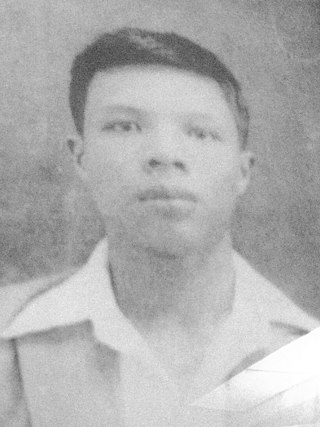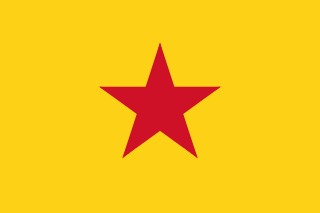This article needs additional citations for verification .(September 2014) |
The following is a list of political organizations and armed forces in Vietnam, since 1912:
This article needs additional citations for verification .(September 2014) |
The following is a list of political organizations and armed forces in Vietnam, since 1912:

The Việt Minh is the common and abbreviated name of the League for Independence of Vietnam, which was a communist-led national independence coalition formed at Pác Bó by Hồ Chí Minh on 19 May 1941. Also known as the Việt Minh Front, it was created by the Indochinese Communist Party (ICP) as a national united front to achieve the independence of the Democratic Republic of Vietnam.

The August Revolution, also known as the August General Uprising, was a revolution led by the Việt Minh against the Empire of Vietnam from 16 August to 2 September 1945. The Empire of Vietnam was led by the Nguyễn dynasty and was a puppet state of Japan within the Greater East Asia Co-Prosperity Sphere. The Việt Minh, a political league de facto led by the communists, was created in 1941 and designed to appeal to a wider population than what the communists could command. The Viet Minh was supported by the US and its OSS Deer Team.

The State of Vietnam was an associated country within the French Union from 8 March 1949 to 4 June 1954, then a sovereign country until 1955. It was the predecessor of the Republic of Vietnam (1955–1975) in South Vietnam that was formed after the country was divided. It was established as an independent and unified country by the 1949 Élysée Accords that took effect on June 14 and were completed on 2 February 1950. It claimed authority over all of Vietnam during the First Indochina War, although large parts of its territory were de facto controlled by the Democratic Republic of Vietnam, which was ruled by communists in reality. It became an observer to the United Nations in 1952 and was recognized by many non-communist states. It was a part of the anti-communist and capitalist Western Bloc during the Cold War.

The Empire of Vietnam was a short-lived puppet state of Imperial Japan between March 11 and August 25, 1945. It was a member of the Greater East Asia Co-Prosperity Sphere. It was led by the Nguyễn dynasty and created when Emperor Bảo Đại declared independence for Vietnam from French protection. At the end of its existence, on 14 August 1945, the empire also successfully reclaimed Cochinchina as part of Vietnam.

Nguyễn Hải Thần was a leader of the Việt Nam Cách mạng Đồng minh Hội and a political leader during the Vietnamese Revolution. He was also the first Vice President of the Democratic Republic of Vietnam for less than a year before fleeing to China.

Trần Văn Cung was a Vietnamese revolutionary, who was the secretary of the first communist cell in Vietnam.

Hà Huy Tập was a Vietnamese revolutionary and the third General Secretary of the Central Committee of the Communist Party of Vietnam (CPV).
The 2nd Politburo of the Workers' Party of Vietnam (WPV), formally the 2nd Political Bureau of the Central Committee of the Workers' Party of Vietnam (Vietnamese: Bộ Chính trị Ban Chấp hành trung ương Đảng Lao động Việt Nam II), was elected at the 1st Plenary Session of the 2nd Central Committee in the immediate aftermath of the 2nd National Congress.

The 1st Central Committee of the Indochinese Communist Party was in session from 1935 to 1951.

The House of Nguyễn Phúc, also known as the House of Nguyễn Phước, was a ruling family of Vietnam. It ruled from the city of Huế in central Vietnam beginning in 1636. As the Nguyễn lords, they often fought with the Trịnh lords, who were based in Hanoi. They were overthrown by the Tây Sơn dynasty in 1776.

The Mặt trận Quốc gia Thống nhất was a Vietnamese political alliance in the short-lived Empire of Vietnam. It was formed on 14 August 1945 in Southern Vietnam uniting all non-Viet Minh factions, including Trotskyists and the southern religious sects of Cao Đài and Hòa Hảo. Following the delayed arrival in Saigon on August 22, 1945, of the former president of the Journalists' Syndicate, and at the time Imperial Commissioner of Southern Vietnam Nguyen Van Sam, the alliance made an official declaration of national independence and territorial reunification.

The Six Provinces of Southern Vietnam is a historical name for the region of Southern Vietnam, which is referred to in French as Basse-Cochinchine. The region was politically defined and established after the inauguration of the Nguyễn dynasty, and called by this name from 1832, when Emperor Minh Mạng introduced administrative reforms, to 1867, which culminated in the eight-year French campaign to conquer the Six Provinces.
Socialism in Vietnam, in particular Marxism–Leninism, is the ideological foundation of the Communist Party of Vietnam (CPV) for the development of the country ever since its establishment.

The abdication of Bảo Đại took place on 25 August 1945 and marked the end of the 143-year reign of the Nguyễn dynasty over Vietnam ending the Vietnamese monarchy. The fall of the Nguyễn dynasty also led to the fall of its Empire of Vietnam de facto controlled by Japan. Emperor Bảo Đại abdicated in response to the August Revolution. A ceremony was held handing power over to the newly established Democratic Republic of Vietnam, which was established during the end of World War II in Asia as Vietnam had been occupied by French and later Japanese imperialists.

The Đại Việt National Socialist Party was a Nazi political party founded in 1936 in Vietnam in the Hội Phục Việt, following nationalism, inspired by the Kenpeitai. It was pro-Japanese, it also supported Vietnamese independence and unification under the Nguyễn dynasty. Its headquarters was located in Hanoi, Northern Vietnam (Tonkin).

The 4th Central Committee of the Communist Party of Vietnam (CPV) was elected at the 4th CPV National Congress. It elected the 4th Politburo and the 4th Secretariat.

The 3rd Central Committee of the Workers' Party of Vietnam (WPV) was elected at the 3rd WPV National Congress. It elected the 3rd Politburo and the 3rd Secretariat.

The Union National Front was a Vietmamese political alliance from 17 February 1947 to 2 July 1949. Uniting all anti-Viet Minh and pro-French factions to founded an independent state.